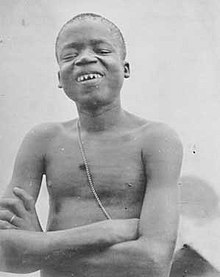Human tooth sharpening


Human tooth sharpening is the practice of manually sharpening the
Historically it was done for spiritual purposes, with some exceptions, but in modern times it is usually aesthetic in nature as a form of body modification.[1]
History
Many cultures have practised this form of
Around the year 1910, the African Herero people participated in forms of tooth sharpening. Both the boys and girls at puberty would have four of their lower teeth knocked out. This was followed by the top teeth being sharpened to points that resembled a "V". The tribe regarded this tradition as a form of beauty. It was said that a girl that had not undergone this procedure would not be able to attract a lover.[3]
In
The Mentawai people have also traditionally engaged in this practice.[6] The Mentawai people believed that the soul and body were separate. If the soul was not pleased by its body it would leave and the person would die. As a result, the Mentawai people started modifying their bodies to be more beautiful. In Mentawai culture, those with teeth that have been sharpened are deemed more beautiful. Tooth sharpening would have been traditionally done at puberty, though contact with outside civilizations has resulted in a decline of tooth sharpening.[7] Today, the Mentawai people use a sharpened chisel and another object that acts as a hammer. They use no anesthetics or pain killers, and bite down on a piece of wood.[8] Green bananas are bitten on to reduce pain after the procedure.[7]
David Livingstone mentioned a number of African tribes who practiced teeth-filing, including the Bemba, Yao, Makonde, Matambwe, Mboghwa and Chipeta.[9]
Koesbardiati, Toetik mentions
Examples in the modern world
- Horace Ridler, "the Zebra man", included tooth sharpening as one of many body modifications he underwent in order to serve as a circus performer.
- In the Indonesian population of Bali, there is a sacred religious practice in which the maxillary front teeth are filed for the purpose of refraining from evil lust.[11] Note that the teeth are flattened, not sharpened.
- In the Indonesian population of Timor, residents file the occlusion surface for beauty purposes as it makes the residents feel more comfortable around others.[11]
- Among the Mentawai people in Indonesia, the wife of the soon-to-be chief decides to have her teeth sharpened as a sign of great beauty.[7]
References
- ISBN 978-0-313-33695-9.
- ^ a b c d e "Grinding Teeth: The Wild Indonesian Coming Of Age Ritual". Vice Asia. 2018-10-30. Archived from the original on 2021-12-21. Retrieved 2019-02-13.
- ISBN 1-4254-9924-4.
- ISBN 1-4254-9924-4.
- ISBN 1-4254-9924-4.
- ISBN 978-1-74104-830-8..
- ^ a b c "Teeth Chiseling". National Geographic. 14 March 2008. Archived from the original on 2021-12-21 – via YouTube.
- ^ "Mentawai Teeth Sharpening". Indigenous Education Foundation (IEF). December 1, 2016. Archived from the original on 2021-12-21 – via YouTube.
- ^ Livingstone, David (1875). The Last Journals of David Livingstone, in Central Africa. From Eighteen Hundred and Sixty-five to his Death. Continued by a Narrative of his Last Moments and Sufferings, Obtained from his Faithful Servants, Chuma and Susi, by Horace Waller, F.R.G.S., Rector of Twywell, Northhampton. Retrieved November 13, 2020.
- OCLC 985158551.
- ^ )
- OCLC 1041736458.)
{{cite book}}: CS1 maint: multiple names: authors list (link
